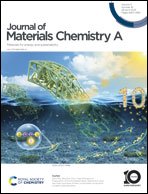Enhanced thermoelectric performance in Bi0.5Sb1.5Te3/SiC composites prepared by low-temperature liquid phase sintering†
Abstract
Amongst thermoelectrics, Bi2Te3 is special owing to its peak performance near room temperature, which enables it to be used for both energy harvesting and cooling. Despite extensive studies on this compound, Bi2Te3-based bulk materials are usually prepared by field-assisted sintering and hot pressing. This necessitates sophisticated equipment and tedious compositional control, both of which are undesirable for large scale applications. In this work, a low-temperature liquid phase sintering (LPS) method was employed to prepare p-type Bi0.5Sb1.5Te3/SiC composites with enhanced thermoelectric properties. In addition, a nearly two-fold increase in the power factor was observed post heat treatment at 350 °C. This can be ascribed to carrier concentration modulation due to porosity induced by heat treatment. Further addition of 0.6 vol% SiC results in a low lattice thermal conductivity of 0.33 W m−1 K−1, which can be ascribed to phonon scattering due to various defects induced by the SiC inclusion. Ultimately, a figure of merit ZT of 1.05 at 340 K was achieved for Bi0.5Sb1.5Te3/0.6 vol% SiC, 20% higher than that of the pristine sample. Moreover, an average ZT of 0.87 at 300–500 K was attained, comparable to state-of-the-art values via high-temperature processing. This work showcases the promising application of the low-temperature LPS technique for energy-efficient processing of thermoelectrics.

- This article is part of the themed collections: Most popular articles from National University of Singapore and 2024 Journal of Materials Chemistry A Lunar New Year collection


 Please wait while we load your content...
Please wait while we load your content...